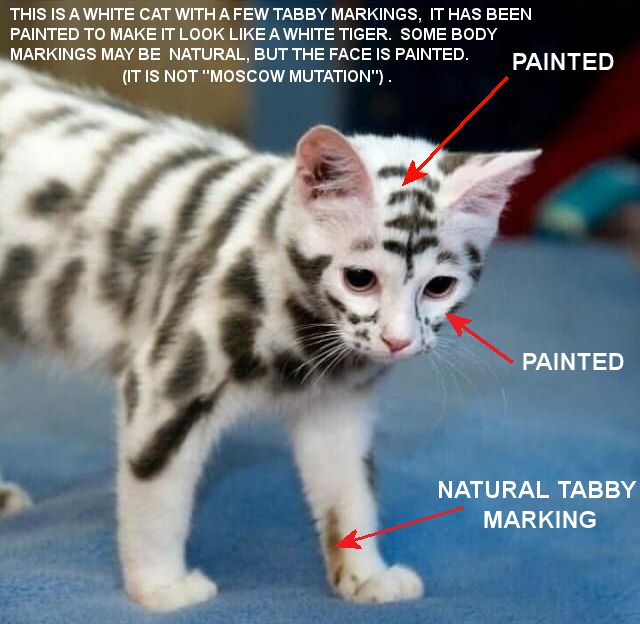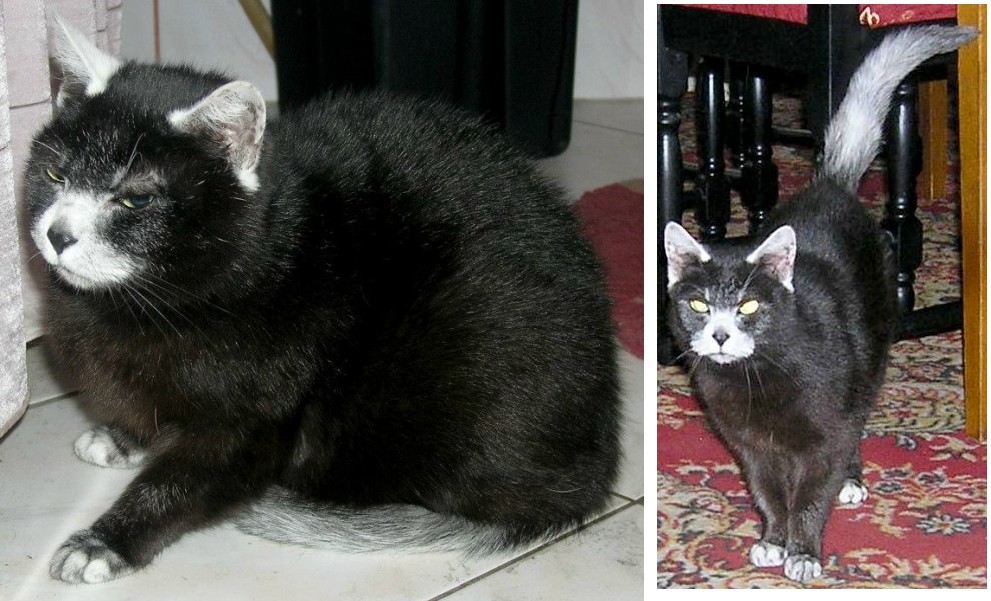
ROAN (SALT & PEPPER) MUTATIONS
Brindled and speckled bicolours are not new, but are only recently being properly noticed in cats. This article covers roan, tweed, karpati (salt-and-pepper) and other "roan-like" patterns. Because "tweed" and "roan" (evenly mixed colour and white hairs) were not accepted terms in the cat fancy, the original Lykoi breed standard called for the breed's distinctive colour to be "solid black" evenly mixed with amelanistic hair. Since then, the term "roan" (meaning intermixture of coloured and white hairs) has been accepted by TICA. The roan colour has a long history. Before they were known to Western cat fanciers, several Thai cat varieties were described and illustrated in the Smud Koi of Cats (circa 1868-1910). One of those breeds, the Saem-Saert, was described as blue roan (salt-and-pepper grizzle) and this colour sometimes crops up in random=bred cats in Thailand and neighbouring countries.
I am often sent photos of kittens that are supposedly roan. Sometimes they are advertised as rare coloured kittens. Almost all of them are due to Fever Coat, described in Indefinable Kitten Colours. Where the roan pattern is due to fever coat the white hairs will be replaced by normal coloured hairs after the first moult and the adult cat will not be roan or any other rare colour.,/P>
See

See Roan: Finnish Mutation for the black roan cats with white spots first identified in Finland and not yet pursued as a breed or pattern.
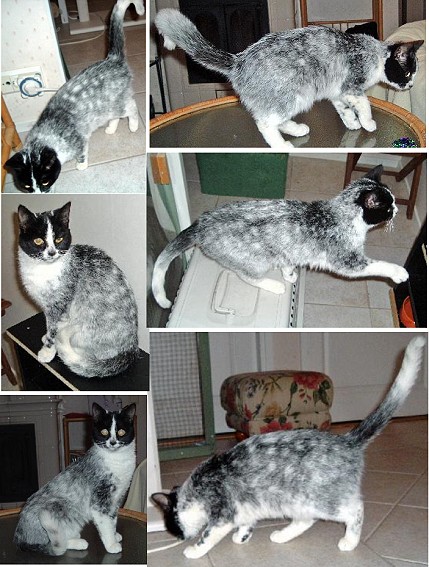
See Roan: Silverdust for the Silverdust breed.
LYKOI BREED
The first breed that allowed "roan" was the Lykoi (a sparse-haired breed). Because roan was not (currently) a recognised colour with cat registries, the cats were registered as solid coloured with amelanistic hair evenly dispersed throughout the coat. The first Lykoi cats were discovered by Patti Thomas and were further developed by Britney Gobble. At first the only permissible colour was black roan - black fur evenly interspersed with white hairs giving a grizzled grey colour. Similar cats occur from time to time and exhibit other roan colours e.g. red roan, blue roan where the white hairs are evenly interspersed with those colours. Because the roan pattern was not the only distinctive trait for the breed, and more foundation cats were found worldwide, other roan colours were recognised, including a white version where the roaning is not visible, but the cats have the distinctive body type and fur type. In Lykois, the sparse hair and the roan colour are inherited independently.

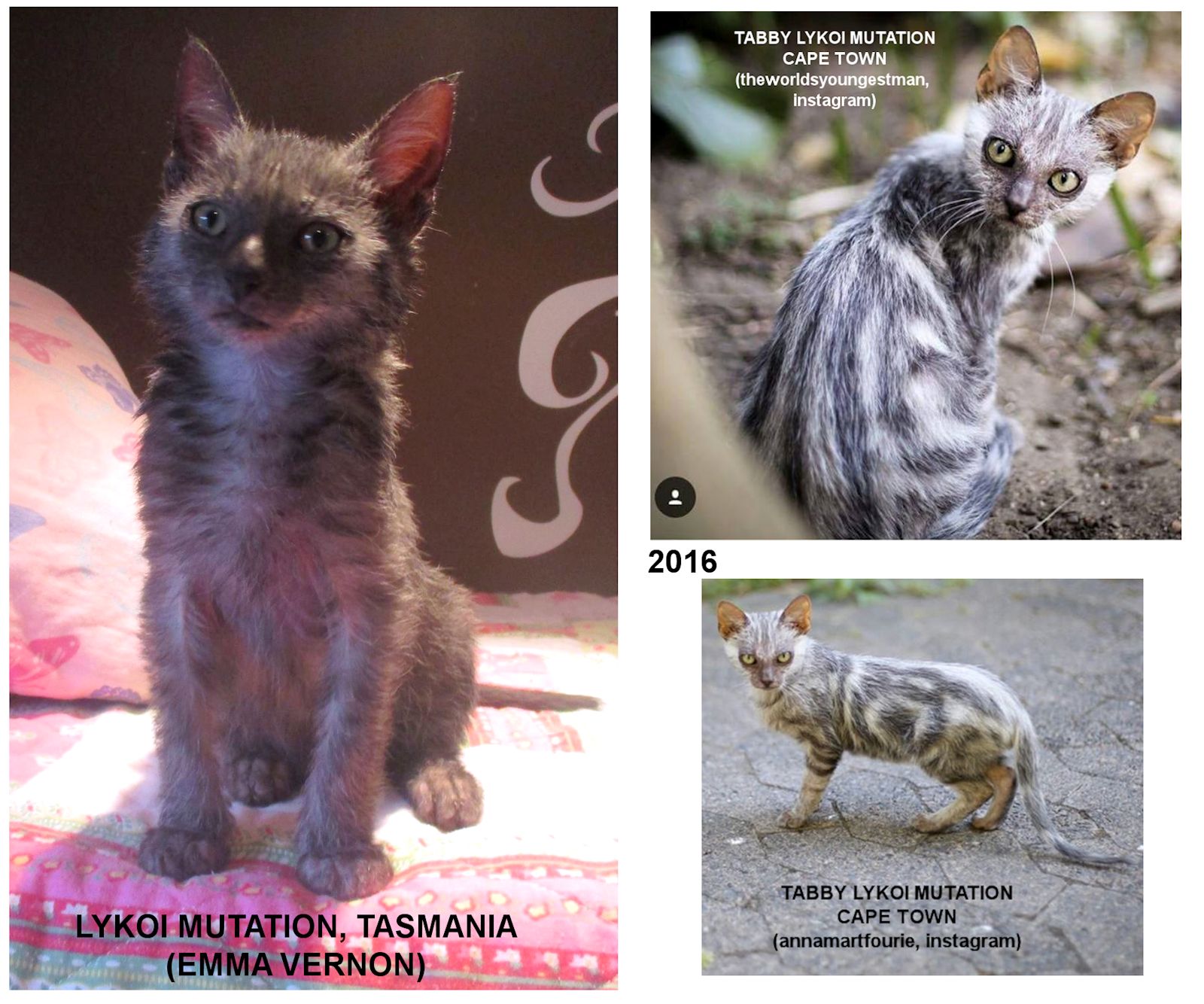
OTHER ROAN AND TWEED CATS
Mochi, below, developed a roan coat due to the interaction of genes for dominant blue eyes. Several cats with a blue-eye mutation were found in Russia and bred together as it was not realised that the mutations were different. Some of the cats had unusual bicolour markings and their initial black or blue markings appeared to turn grey as the colouyred hairs were replaced by white hairs. The roan pattern was not desirable in the breeds using the dominant blue eye genes and the cats were not bred from.
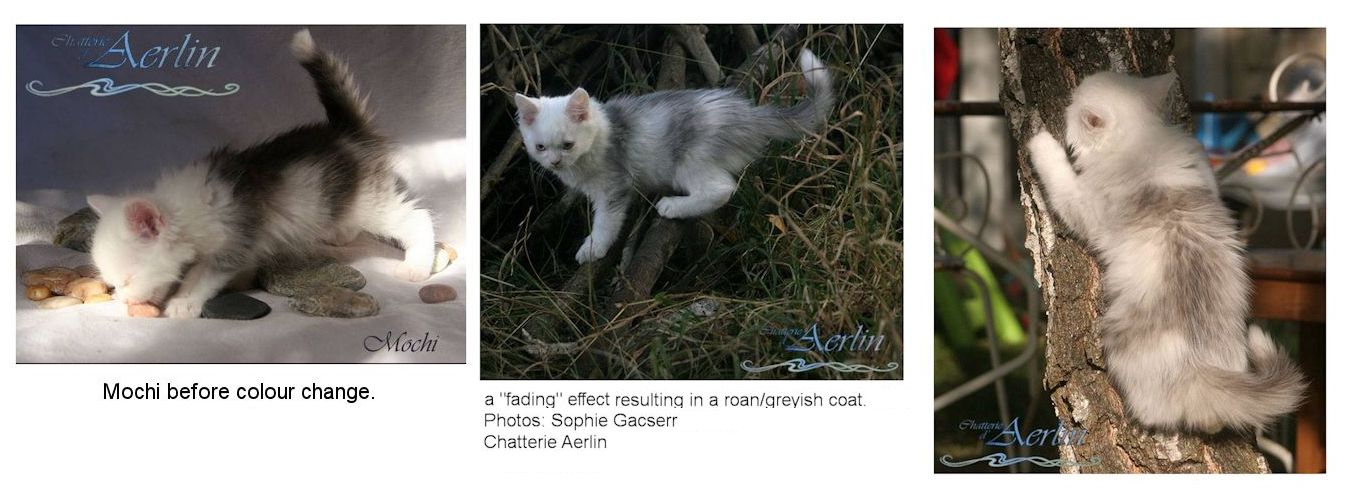
|
Two adult ferals from Chelmsford, England, in the early 1990s. The male is a ticked cream and the female has the salt-and-pepper effect. |
A tweed kitten are from Claire Jones in Surrey, England. Claire runs a rehoming cattery and took in the tweed kitten for rehoming. I don't know if the roan pattern was permanent or was a form of fever coat (a temporary condition, most often due to the mother being ill during pregnancy, or the affected individual being ill). High body temperature can prevent melanin forming in the growing hairs. |
In 2008, examples of brindled black and white "tweed" were reported. One was a "tweed" kitten called "Ezekiel" from Utah, rescued from a reservation as a feral kitten and now being exhibited as a household pet. Another was a kitten shown in Detroit, handed into the shelter with its parents, both of whom were bicolours. Both were neutered so the mutation cannot be investigated. Compulsory spay/neuter (before adoption) in the USA is preventing these new mutations in random-bred cats from being investigated.

Another tweed cat was a purebred Exotic, but the white brindling came and went. Another tweed that was temporary was a shelter kitten named "Versace" that arrived with dilute calico and tabby-tortie littermates. Versace had black roots to her fur and the remaining three-quarters of each hair was white and black ticked, indicating a disruption in pigment deposition. After she moulted and and grew her adult coat she was tortoiseshell so the temporary tweed effect seems to be a phaeomelanin failure like Pandora and Kuuru, probably fever coat.
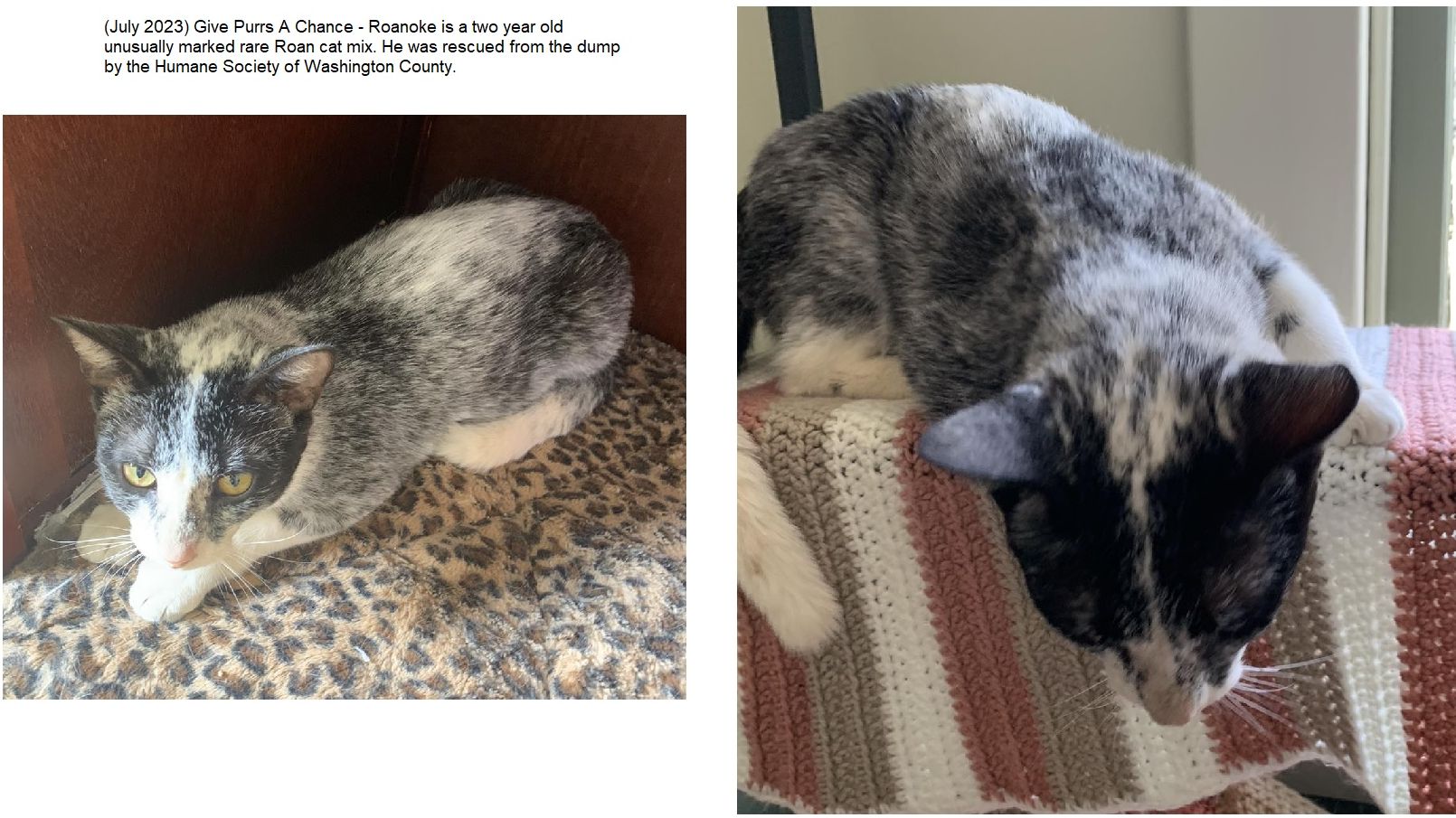
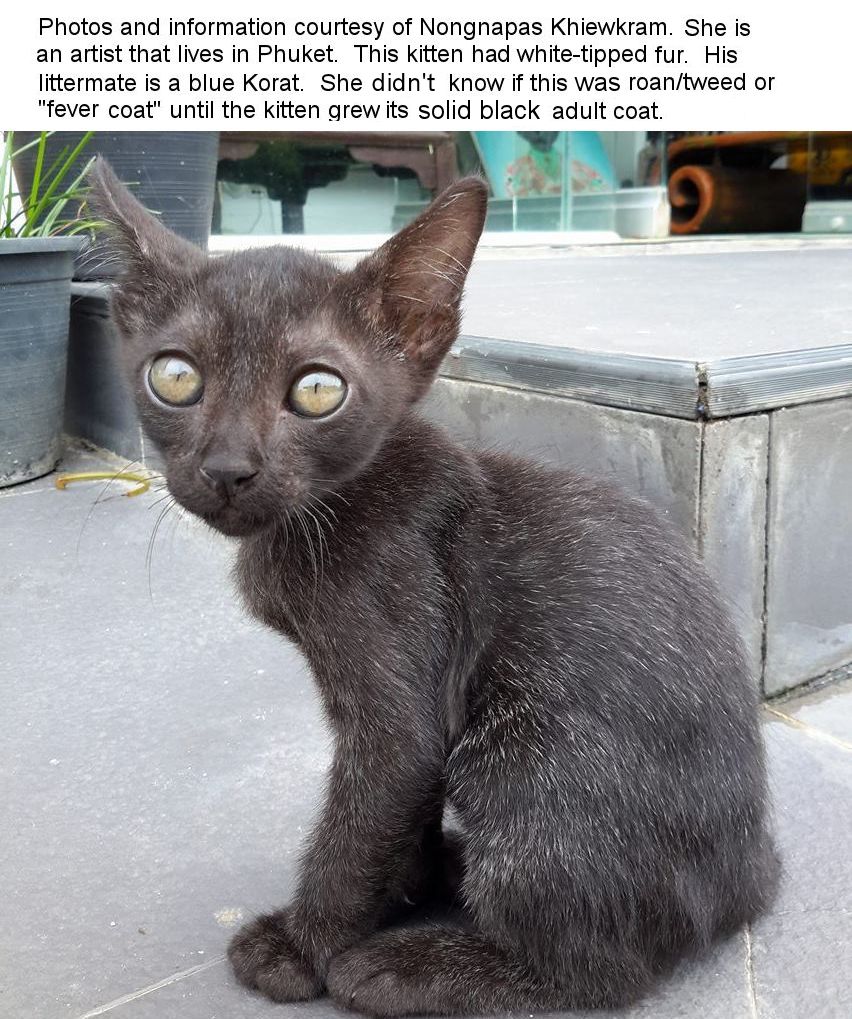
POSSIBLE PHAEOMELANIN (RED PIGMENT) FAILURE
Pandora (owned by Bill B, Granby, MA, USA) is a brindled cat with what appears to be an unusual mutation. She has the brindled pattern normally seen on tortoiseshell cats, but the patches which should be red are white! The brindling and facial pattern is typical of tortoiseshell cats, but it seems that 15 year old Pandora has a mutation that prevents her producing red pigment. Is this roan/tweed, or is the gene that should produce red pigment faulty? Since Pandora was spayed before Bill obtained her, it isn't possible to breed her to see if it can be inherited.
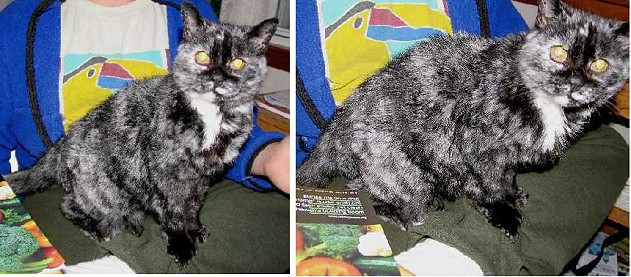
PROGRESSIVE PIGMENT LOSS
While checking my archives, I found this from Tim Russell in 2005: My cat, Galileo, is an otherwise healthy male with a classic tuxedo coat. He's a little small for a male and has always had a pink nose (with dark spots) and pink paw pads. His eyes are standard greenish yellow. At about 18 months the fur on his ears turned white. The sprinkle of white hairs on his nose grew until there was all white hair between his eyes and down his nose. His tail (previously all black) has turned to a salt-and pepper mix of black and white with the tip now being almost all white. And his black areas on his back and thighs are a salt and pepper mix. I wonder if he's going to turn all white! I have had him checked out by a vet and they said he seems in perfect health. I would agree: he's frisky, happy, and has a fine appetite.
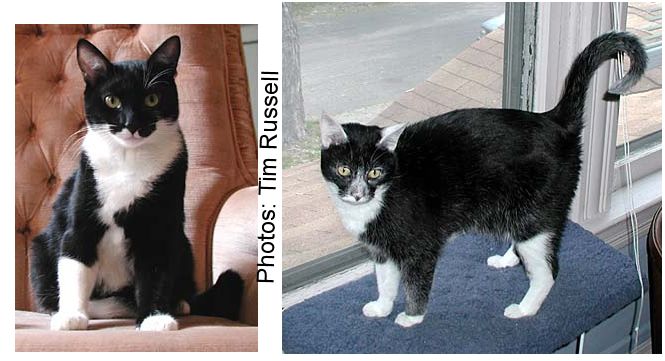
Neptune is owned by Karen Tanner and has turned from black specked with white to white speckled with grey! At the same time, he has some unique white markings on his face, and his nose has turned black at the same time as his fur lightened. Karen acquired Neptune from a Humane Society in San Jose, California in 2001, when he was at least 1 year old and already neutered (so no possibility of seeing if his trait is hereditary). In earlier photos he is black with white speckles and a pink nose, plus an unusual white splotch on his tail (which is now more or less gone as his colour changed). His fur started getting gradually lighter and his nose darker. By 2004 he still had a pink nose and the white splotch on his tail, but by 2012 he looks a pale grey and his white splotches are harder to discern.
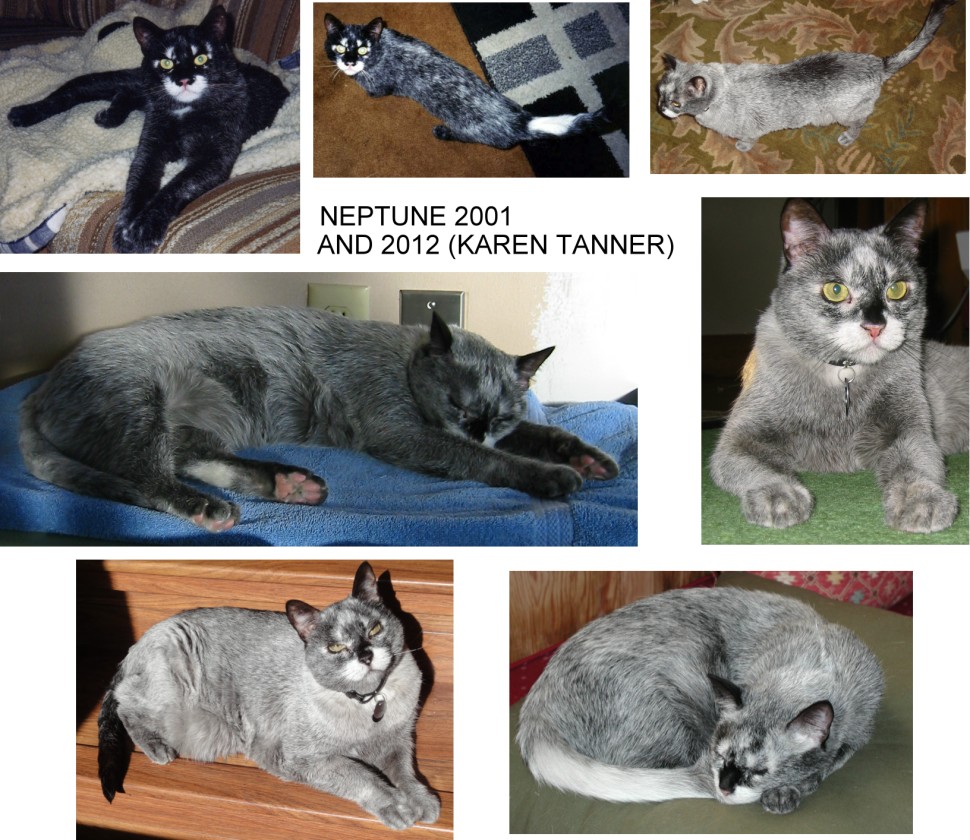
MOSCOW MUTATION
This odd tabby pattern was seen in a semi-feral cat living in Moscow. It appears that the normal banding of the hairs has failed, leaving the tabby markings grey or roan, and leaving the background almost white. Enough photos exist of the cat to rule out digital editing and it does not appear to have been dyed, although this cannot be completely ruled out. There are no close-up images of the cat. A number of copycat versions exist where white cats have been painted to resemble white tigers.

The cat below is mostly white with some small amounts of brown tabby. The tiger-like markings have been added using dye.
